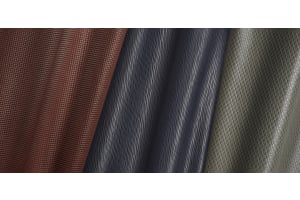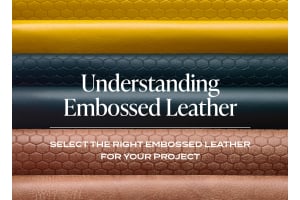A Comparison of Abrasion Tests for Upholstery
Clients frequently ask how leather will perform over time, especially when they are considering using it in high traffic areas. Many manufacturers conduct different abrasion tests on materials to gauge how a material will wear. Clients looking to use leather often refer to these test results to help determine what product is best for their application. Let’s compare three popular types of abrasion tests.
Wyzenbeek Testing for Fabrics
Many manufacturers use the Wyzenbeek Test to measure the abrasion resistance of fabrics. For the Wyzenbeek Test, an operator secures pieces of the test specimen onto a machine. Heavy canvas passes back and forth along the specimens. One back and forth motion equals one double rub. You will find the results for this test expressed as a number of double rubs.The test measures the maximum number of double rubs achieved before the piece of fabric shows noticeable wear, normally defined as two yarns breaking. Designers usually prefer products that complete at least 30,000 double rubs when specifying fabrics for high traffic areas.
We typically do not use this test for leather because leather does not have yarns or linear strands to break. We have conducted this test on some of our most durable semi-aniline products, including Avion and Chatham. The test reached 100,000 double rubs for these products before showing wear on the leather finish.
Martindale Tests for Fabrics
Some manufacturers use the Martindale Test for fabrics. Unlike the Wyzenbeek test that rubs along the warp and weft of a fabric, the Martindale test rubs the fabric in a rotating figure-8 pattern. This tests the abrasion resistance in multiple directions along the fabric’s surface. The abrasion material is different as well. You will find the results for this test expressed as the number of cycles completed before the fabric shows noticeable signs of wear. Signs of wear include two or more yarns breaking, piling, or holes forming. Typically, designers prefer products that achieve at least 40,000 Martindale cycles for high traffic areas.
Taber Abrasion Tests for Leather
Leather is a natural material with a drastically different composition than man-made fabrics. Fabrics are typically uniform in weave with linear woven strands. Leather, on the other hand, is comprised of complex collagen fibers that are tightly intertwined. It is this intricate structure that allows for high flexibility, yet provides incredible strength and durability. Therefore, instead of the Wyzenbeek or Martindale methods, we test abrasion performance for leather with a rotary method called a Taber Abrasion Test.
For the Taber Test, the operator adheres a round, cut piece of leather to a thick paper backer and places it on a horizontal wheel that spins, similar to a record player. The operator may use different types of wheels for the abrasion material. The two most common are CS-10, which is mildly abrasive and H-18 which is more abrasive. The operator also uses weights to control the pressure of the wheels on the leather specimen. Typically, the operator uses either 500 gram or 1000 gram weights. We typically use CS-10 wheels with 500 grams for our Taber Abrasion tests. You will see results listed in cycles. We normally recommend products with 1000 or more cycles with CS-10 and 500 grams for high traffic areas.
It is important to note that leathers with a wax finish, such as Journey or Distressed, will immediately show wear during the Taber abrasion test. However, these types of leather will still have a very long service life in high traffic areas, such as hotels and commercial lobbies.This wax finish products tend to improve with age and develop a rich patina with use.
Summary
Different abrasion tests are used for different types of materials. The Taber Test uses a different type of abrasive material Results are expressed as cycles that spins over differs from Wyzenbeek and Martindale in a number of ways. First, Wzynbeek has a rocking arm that rubs back and forth on fabric, while the Taber test uses a spinning wheel that spins the leather. The Taber is similar to Martindale in that both involve circular motion. However, Martindale rubs fabric in a figure-8 pattern while Taber is strictly a circular motion. Second, both the Wzenbeek Test and Martindale method use softer materials to wear down the fabric speciman. The Taber Test, on the other hand, uses a more abrasive wheel that is similar to an emery board or sandpaper. Third, instead of double rubs, the results for Taber Tests are expressed as a number of cycles. The number of cycles from the Taber test are usually significantly less than the number of cycles from the Martindale method, even though leather typically outlasts man-made fabrics.
If you have any questions about these or any of our testing methods, please feel free to contact us.








